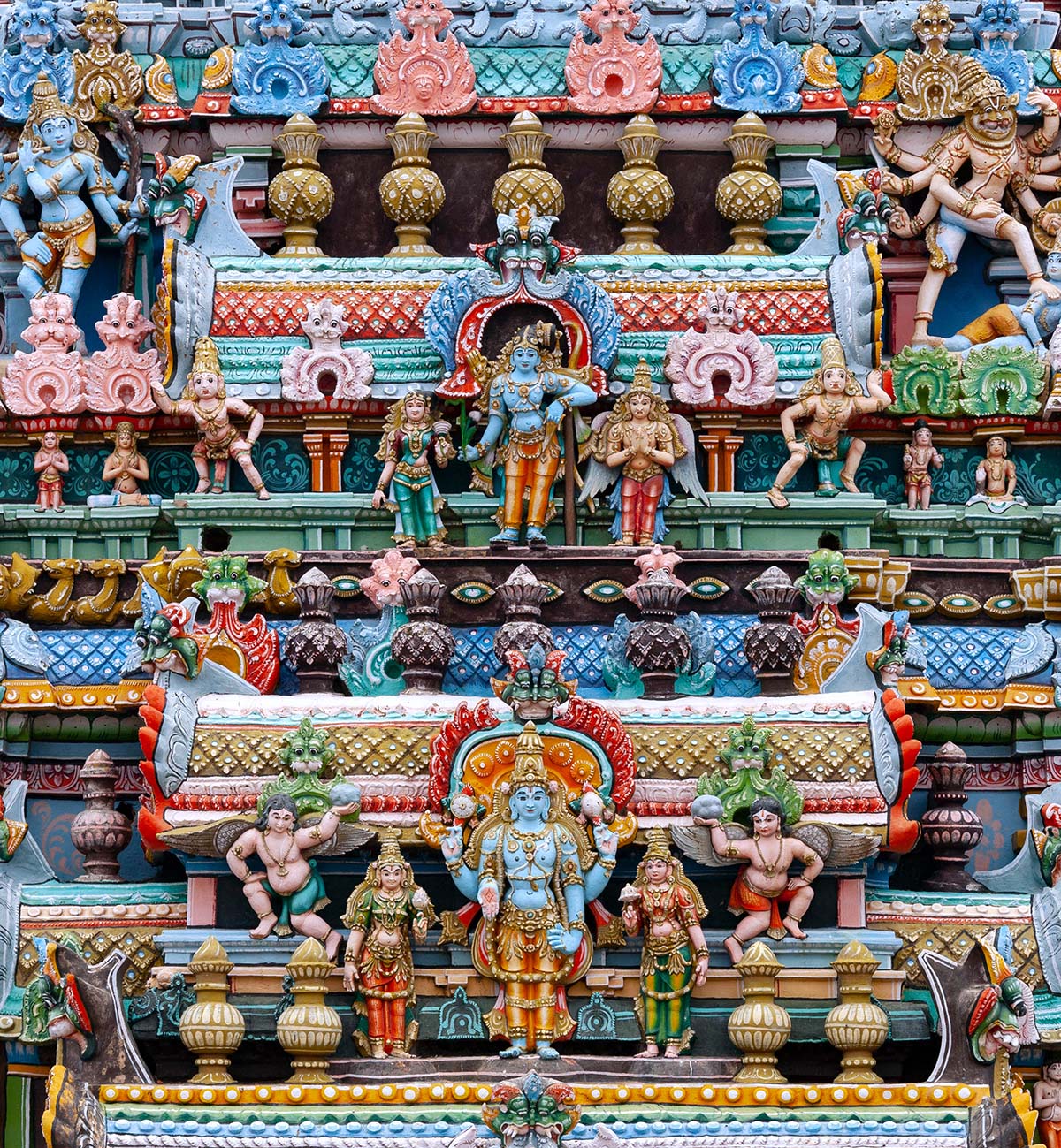ARTICLE
Meenakshi Temple, Madurai
Also known as the Meenakshi Sundaresvara Temple, the Meenakshi Temple is a historic temple complex located in the city of Madurai in Tamil Nadu, South India. One of the 275 paadal petra sthalams – a list of important Saivite sites mentioned in the devotional poetry of the Nayanars – the complex is built in the Dravida style of temple architecture and houses a large number of artistically significant sculptures.
The principal deities of the temple are the consorts Meenakshi and Sundaresvara. Meenakshi, the patron deity of Madurai, is a form of Parvati, while Sundaresvara is worshipped as a form of Shiva. In the early medieval period, Sundaresvara was considered the main deity of the temple. Over time, Meenakshi was accorded equal status as well.
The shrine is speculated to have existed as a structure since the seventh century CE. Its present form, however, has been shaped by the patronage of a succession of rulers from the twelfth century to the colonial period. The Pandya kings, who governed their territory in southern India from Madurai, considerably expanded the temple complex and its structures, rebuilding the central shrines as well as the gopurams (entrance gateways). Inscriptions within cite Jatavarman Kulasekara Pandya (r. 1119–1216 CE) and Maravarman Sundara Pandya (r. 1216–1238 CE) as its patrons.
In the early decades of the fourteenth century, the temple complex suffered considerable damage during Malik Kafur’s raid of southern India and remained closed for several years, until the military commander Kumara Kampana defeated the Madurai Sultanate and brought the region under the rule of the Vijayanagara empire in 1365. The Madurai Nayakas, who began as feudatories of the Vijayanagara empire and later independently ruled Madurai, expanded the temple significantly and built several structures, including gopurams, mandapas and shrines. During their reign, which spanned the sixteenth to eighteenth centuries CE, the patronage of the Madurai Nayakas included its rulers as well as their queens and other notable members of the court, extending to not simply architectural contributions, but also sculptural art and portraits of the royal patrons. The next significant additions to the temple complex came in the late-nineteenth century, during colonial rule, when the mercantile community known as the Nattukkottai Chettiars or Nakarattars sponsored structural work such as the completion of the northern gopuram.
Today, the temple complex is demarcated by a large perimeter that encloses an area of approximately fourteen acres. The two principal shrines face east, with the Sundaresvara shrine being located to the north of the Meenakshi shrine. Both shrines have gilded vimanas. The Golden Lily Tank, another prominent part of the temple complex, is located adjacent to the two central shrines. In addition to the principal shrines, there are shrines dedicated to deities such as Ganesha and Nataraja, Nandi, the navagrahas, and the Sangam poets, and a group of smaller Shiva shrines known as isvarams.
The complex has eleven gopurams, of which the four on the outer walls are the largest. The eastern gopuram, the primary entranceway to the temple, is considered to be the oldest of these structures, while the southern gopuram, near the Golden Lily Tank, is the tallest and dates to the sixteenth century. The Raja Gopuram located outside the eastern entrance of the temple is an unfinished gateway that was commissioned by Tirumala Nayaka in the seventeenth century CE. The remnants of the gateway suggest that it would have been the largest entranceway of the complex on its completion.
The temple complex also houses several mandapas, which are significant from a historic as well as an artistic perspective. The Kambatti Mandapa, dating to the sixteenth century, houses a Nandi shrine and pillars with sculptures depicting various forms of Shiva. The Airakkal Mandapa, located in the north-eastern part of the complex, is also known as the Thousand-Pillared Hall. It houses a shrine to Nataraja along with 985 pillars that bear detailed carvings of several divine, royal and mythical figures. It is also the site of the Meenakshi Temple Museum. The hall was constructed by Ariyanatha Mudali, a general of the Madurai Nayaks, during the reign of Krishna Virappa Nayaka (1572–1595 CE). The Kilikatti Mandapa, near the Golden Lily Tank, is notable for its sculptures and paintings, which depict forms of Shiva, Subrahmanya, Devi and Ganesha. The Pudu Mandapa, built between 1626 and 1633 CE by Tirumala Nayaka, is located outside the main complex in line with the eastern gopuram and has carvings of yalis, as well as sculptural portraits of the Nayaka royal family. Along with the Viravasantaraya Mandapa and the Ashtashakti Mandapa, it presently serves as a retail space for a variety of goods and souvenirs.
Apart from the expansive thematically complex sculptural programme of the temple, the temple is also known for its paintings, particularly paintings on wood panels dating to a century ago. Originally placed near the Golden Lily Tank, historians believe these painted panels are replicas of murals located in the Chitra Mandapa and were placed over the walls. The original murals are unlikely to have survived. The wood paintings are preserved in the collection of the Temple Museum.
Bibliography
Our website is currently undergoing maintenance and re-design, due to which we have had to take down some of our bibliographies. While these will be re-published shortly, you can request references for specific articles by writing to hellomapacademy@map-india.org.








